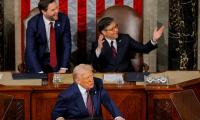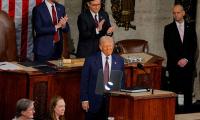KARACHI: Pakistan will continue to have favourable economic growth if annual inflation remains around six percent, a central bank’s study said on Monday, warning, however, of negative outlook in case of uptick from the percentage point.
“Keeping in view estimated threshold inflation levels, we can safely conclude that as long as inflation rate in Pakistan remains around 6 percent it will be favourable for economic growth,” the research study, titled ‘Threshold Inflation in Pakistan’, of the State Bank of Pakistan (SBP) said.
“Inflation higher than 6 percent can hurt economic growth.”
Government projected growth and consumer price inflation at six percent for the current fiscal year of 2018, above from the SBP’s projections of five to six percent for GDP growth and 4.5 to 5.5 percent for inflation.
The International Monetary Fund sees Pakistan’s economy to expand at 5.6 percent in FY2018, with much of the growth fuelled by improved energy supply and investment related to the China-Pakistan Economic Corridor.
Since January, the central bank has adopted a tight monetary policy to address inflationary risk and widening external imbalances.
Analysts, however, expected inflation to rise in the coming months in the wake of rupee depreciation and increasing international oil prices.
The study said on average one percentage point increase in inflation is associated with 0.74 percentage point increase in real GDP growth in Pakistan when inflation is below threshold level and 0.53 percentage point decrease in real GDP growth, when inflation is above threshold level.
Historically, average real GDP growth rate has been more than five percent during the low inflation periods (i.e., inflation rate below 6 percent), and 4.7 percent during very high inflation periods (i.e., inflation rate above six percent).
“There was only one year (1990) when inflation was at six percent and average real GDP growth was recorded at 4.6 percent – lower than its historical average,” the research paper said.
“There is a consensus that a low inflation rate helps economic activities, while high inflation hurts economic growth.”
The study said high inflation environment affects decision making of all economic agents in economy, like investors, savers, consumers and producers through uncertainty about the expected payoffs from their decisions.
“Moreover, a persistently high inflation also causes erosion of the value of the local currency in terms of foreign currencies,” it added. “Such uncertainties, in turn, have adverse implications for economic activities.”
The research paper said low inflation helps economic agents to predict outcome of their economic decisions with fair level of certainty. “Especially, producers follow their plans for business expansion with more confidence; and new investment is undertaken in the expectation of predictable returns. This is precisely the reason why policy makers, particularly central banks, strive for low inflation.”
In case of Pakistan, the question about how much inflation is good for growth has becomemore important.
The researchers Muhammad Farooq Arby and Amjad Ali, using two models: a quadratic model, and a regression kink model with unknown threshold for the period from 1976 to 2017, found that the threshold inflation rate for Pakistan was around six percent.
Martin Dow official receiving award. — Instagram@martindowltd/FileKARACHI: Martin Dow, a leading pharmaceutical and...
CEO of Abacus, Fatima Asad holding award, February 28, 2025. — Facebook@bacusGlobalKARACHI: Abacus, a leading...
A photo from Awards & Conference 2025 released by NBP on their Instagram account....
Lucky Investment officials posing for photo after inauguration of their new office at the Finance and Trade Centre,...
An image of a JS Bank branch in Karachi.— Facebook@JSBank/FileKARACHI: JS Bank Limited posted a consolidated profit...
Ingots of 99.99 percent pure gold are placed in a workroom at Krastsvetmet precious metals plant in the Siberian city...







